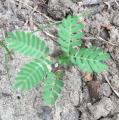
DMT-Nexus member
Posts: 463 Joined: 21-Dec-2013 Last visit: 28-Dec-2019
|
Orion1 wrote:And if anyone is looking for some different acacias like colei- cole wattle(5%yeild), Accuminata long leaf-rasberry jam(1.75-2.5%), and narrow leaf-sub species rasberry jam, both with good yeilds supposedly, also the maidenii- maiden wattle(up to 6%), check out nindethana seeds Western Australia, at the time of my purchase they were out of obtusafolia- blunt leaf wattle(3%) but the sub species longifolia sophorae grows wild on the sand dunes at the beach here but another with reasonable yeild i am told and they have them in stock too, all at most than reasonable price. They are also a founding? member of greening australia and the first seed bank in Au. So no money touches monsanto or du points hands Some of those %'s sound questionable. Does it say what particular alkaloids make up the percentages? I was under the impression that acuminata was the king of alkaloid content, but this suggests it's inferior to obtusifolia. I'm not familiar with colei yields, but maidenii up to 6% (if we're talking DMT) sounds inaccurate... Throughout recorded time and long before, trees have stood as sentinels, wise yet silent, patiently accumulating their rings while the storms of history have raged around them --The living wisdom of trees, Fred Hageneder
|
|
|
|
|

DMT-Nexus member
Posts: 1893 Joined: 18-Jan-2008 Last visit: 26-Sep-2023
|
--Shadow wrote:Orion1 wrote:And if anyone is looking for some different acacias like colei- cole wattle(5%yeild), Accuminata long leaf-rasberry jam(1.75-2.5%), and narrow leaf-sub species rasberry jam, both with good yeilds supposedly, also the maidenii- maiden wattle(up to 6%), check out nindethana seeds Western Australia, at the time of my purchase they were out of obtusafolia- blunt leaf wattle(3%) but the sub species longifolia sophorae grows wild on the sand dunes at the beach here but another with reasonable yeild i am told and they have them in stock too, all at most than reasonable price. They are also a founding? member of greening australia and the first seed bank in Au. So no money touches monsanto or du points hands Some of those %'s sound questionable. Does it say what particular alkaloids make up the percentages? I was under the impression that acuminata was the king of alkaloid content, but this suggests it's inferior to obtusifolia. I'm not familiar with c yields, but maidenii up to 6% (if we're talking DMT) sounds inaccurate... Agreed, by all accounts that Ive heard of and read most of those figures are way out. Acacia simplex I believe is the highest yielding.
|
|
|

Wiradjuri
Posts: 182 Joined: 15-Dec-2011 Last visit: 28-Mar-2015 Location: Australia
|
^ that's according to internet lore . ime you can never accurately predict yields . alkaloid content is affected by seasonal, regional, maybe even diurnal variation, variation in soil composition, recentness of rain, microbial activity (?) who knows . percentages quoted from people who post in online forums are sketchy for a number of reasons. at the other end of the scale, CSIRO publications, or books such as Willaman & Schubert's alkaloid bearing plants and their contained alkaloids (or if you're lucky, non-circulated research papers from various unis or private research groups) - ALL use either GCSM or extraction methods that are dangerous to laymen, and so complicated it will make your teeth hurt, (and materials that are unobtainable) - meaning you are unlikely to replicate their results.
Acacias are not entry level 'dmt plants'. in fact, many of the 'high yielding' wattles contain PEAs such as β-methyl-phenethylamine, which have unknown activity in humans and should be approached with caution. I'd estimate that PEA containing wattles outnumber tryptamine containing wattles by 20:1. pm nen888 if you don't believe me.
if you don't know plant taxonomy, and don't have a sound understanding of chemistry, you can seriously hurt yourself trying to do the things that people talk about in this thread.
Just saying.
|
|
|

DMT-Nexus member
Posts: 1893 Joined: 18-Jan-2008 Last visit: 26-Sep-2023
|
Yeah maybe I should have put highest reported alkaloid content on the net.. The plant world is hardly a benign garden of harmless alkaloid resources if you dont know what your are doing or choose the wrong tree you could easily harm yourself or others. Nen has repeatedly emphasizied safety and PRIOR KNOWLEDGE. Changing the subject Ive been paying attention to this a.pycantha and how it grows, I posted a picture a year or so back of it being roughly half the size. So grows almost 6 foot a year by the look of things! Also attached photos of examples of symbiosis, I saw the butterfly land on the phyllode but then couldnt see it , took a close up to find it again. Using the acacia to hide itself from predators. DreaMTripper attached the following image(s):  PSX_20141231_141601.jpg (5,357kb) downloaded 258 time(s). PSX_20141231_141741.jpg (5,789kb) downloaded 255 time(s). P1020421.JPG (5,680kb) downloaded 255 time(s).
|
|
|

DMT-Nexus member
Posts: 1129 Joined: 12-Jul-2014 Last visit: 20-Jan-2024 Location: on the world in time
|
This may be a bit off topic but I just read nen's article in the nexian. http://the-nexian.me/hom...-killing-the-environmentThat's so sad. But thanks for writing that. I'd also like to thank everyone who grows the plants. I just received some Acacia Confusa, Nilotica and Madenii seeds. I won't be ordering bark anymore.
|
|
|

DMT-Nexus member
Posts: 12 Joined: 13-Apr-2014 Last visit: 21-Feb-2015
|
Wow. Me too. I am so sorry that it has come to this. I too have noticed increased interest in the US. Even though most species of acacia are introduced here, they still have the right to exist and tell the story of our agriculture here in the west. It would be cool to use some genomic testing and track retail sources to places. Time for nexians to ranger-up!
|
|
|

DMT-Nexus member
Posts: 14 Joined: 07-Dec-2014 Last visit: 03-Apr-2018 Location: South Africa
|
Acacia Karroo Hayne testI recently conducted my first attempted extraction with Acacia Karroo. I obtained a lot of bark from a farm in the Karoo, both root bark and trunk bark. The plants were ripped out of the ground by excavation machinery for a new pipeline that's being installed, leaving the roots perfectly exposed for collection. I saw that Arczilla said he was planning an extraction of Acacia Karoo but I haven't been able to find the results, so I decided to go ahead and do an extraction. 1st attemptI used the ACRB tek by Thick-Light, pretty much as is, using benzine as a solvent (not benzene). My first extraction was on 50g of shredded root bark. I pooled the three pulls and placed them in a freezer overnight. I noticed white crystals forming, but it turned out it was just ice crystallising in the solvent. I later decided to evaporate the solvent, and found absolutely nothing but a slight discolouration of the glass dish. No tryptamine smell. 2nd attemptI did a second extraction attempt because on my first run I boiled the acid extract almost dry. The second attempt was on 100g of trunk bark. In this run I used half the specified solvent per pull (expecting a much lower yield than ACRB). This time I also used properly sealed containers for freeze precipitation to prevent ice crystals. I've noticed tiny amounts of oil-like bubbles at the bottom of the container but it looks like this might also yield zilch. I'm busy evaporating the solvent to see if there's anything at all and I'll report on that tomorrow. Considerations to take into accountI wouldn't rule out this species as a DMT source just yet... Unfortunately I'm not sure when the plants were pulled out, but I'd guess somewhere around November/December. I collected the samples a few days ago. There has been a bit of rain on the farm. Perhaps this could wash out the DMT? I noticed the roots were not as red as I expected them to be. The plants were growing next to irrigation ground, which means they have had plenty of nutrients and water, and I've seen a theory that excess water could decrease DMT production. How about my extraction methods? If there were any alkaloids at all, would this tek show some trace at least? Possible new ideas and future workI've come across the idea that heavy browsing of foliage could stimulate tannin production as a defence mechanism of the plant. Could this be associated with an increase in DMT production as well? If so, I could find some trees on the farm that are more water-starved and are browsed frequently. If this species can produce DMT at all, I would love to do a large scale experiment to determine the effects of water, nutrients and browsing on DMT content of acacias (or this species). Find some correlations? Let me first find one that actually has DMT  EVERYTHING IS NOTHING!
|
|
|

DMT-Nexus member
Posts: 28 Joined: 11-Jan-2015 Last visit: 06-May-2015
|
Just joined this forum and started reading through this thread and on page 1 it states A. acuminata is mainly distrubted in SA where as Im under the impression it is mainly found in WA with A.(sub species acuminata) burkitti being more prevalent in SA
|
|
|
member for the trees
  
Posts: 4003 Joined: 28-Jun-2011 Last visit: 07-Mar-2024
|
^..yes, thank you for spotting that..ridiculously, i've never properly re-read or checked the OP ! A. acuminata is found predominantly in WA, and is described as such later in the thread..also, in the OP, i would have been including subspecies burkittii, or A. burkittii, which extends the range through to western NSW, and is widely distributed in central inland South Australia, as well as WA..thanks for being sharp Sharps  is fixed.. always appreciate typos or errors being pointed out.. ^...^speaking of..those various species percentages posted earlier Orion1..in all cases, except acuminata, adding a decimal point would get nearer the ballpark..but as pointed out, one or two reported results do not mean that's what will definitely be in the plant.. potatokorpse thank you for your experiment in the pursuit of knowledge ! yes it is known for excess water and phosphorus to decrease alkaloids in some plants, and for water stress and nitrogen to increase them.. i assume that you checked the method with a known, positive, control.. BundleflowerPower and bbing..i appreciate your sentiments and comments..thank you both of you.. yes, i can only the hope the long term negative consequences of such destructive actions are becoming clearer to the people who would do or did this.. CosmicSpore, -Shadow, and DreaMTripper..you people are solid! and Seldom, thanks for the heads up earlier on the golden wattle..  ..the above mentioned tree destruction/exploitation actions have put me in a highly meditative mood of late on the topic of acacias (and in quiet discussion of actions that can discourage such behaviour) ..and spiritual matters, of course..and time to work on book.. Acacians, and the eco-conscious generally, may the joy of trees illuminate..and mutually sustain.. respect to the trees .
|
|
|

DMT-Nexus member
Posts: 28 Joined: 11-Jan-2015 Last visit: 06-May-2015
|
Cheers for the reply nen! I recently conducted some experimentation into some A. acuminata bark that was harvested from a dead tree (had been dead for awhile) and had some successful results that I'd like to share somewhere on the forum  I was very interested in the results as they differed greatly from A. confusa which is the only other plant I have experimented with in the past. Would this be the place to share? I have plenty of images and A. acuminata var was a narrow leaf phyllode based of my I.D. (Im a biology student so I feel like I know what im doing! ahah) however there was a few live acuminatas at different stages of growth nearby some which seemed to have thicker leaves but nevertheless i'd assume they were all acuminata species!
|
|
|

DMT-Nexus member
Posts: 14 Joined: 07-Dec-2014 Last visit: 03-Apr-2018 Location: South Africa
|
nen888 wrote:i assume that you checked the method with a known, positive, control.. Nope, this was my first attempt  I plan to test my methods on well-known plants and then come back with a fresh sample of A. Karroo that is further away from farming activities, ie. water-stressed and not nuked with fertilizer. EVERYTHING IS NOTHING!
|
|
|
member for the trees
  
Posts: 4003 Joined: 28-Jun-2011 Last visit: 07-Mar-2024
|
^ look forward to hearing more..but, yeah it is possible to get a negative result from material which does contain alkaloids depending on the technique..there are possible reasons too, which i'll look at in the future, as to why standard methods can fail on some alkaloidal acacias, which i suspect happens more than most people realise.. and Sharps..yes this is the thread to share experimental results, data, theory and musings on all things acacian  , is good to have you here with your science background.. ..on the subject of science and acacias..there is the 'eTree'..it was modelled on the desert acacias of the middle east, to maximise the capturing of sunlight for solar power..such is the evolutionary wisdom of the acacia.. the eTree is destined for China soon: http://english.cntv.cn/2...DE1417672323146265.shtmlbe well acacians.. . nen888 attached the following image(s):  eTree.jpg (56kb) downloaded 145 time(s).
|
|
|

DMT-Nexus member
Posts: 28 Joined: 11-Jan-2015 Last visit: 06-May-2015
|
Awesome! Ill get to writing a report up Asap!  thanks for the reply, love the E-Tree !
|
|
|

DMT-Nexus member
Posts: 28 Joined: 11-Jan-2015 Last visit: 06-May-2015
|
This is my Acacia acuminata (narrow phylloyd variant) report on an extraction I did awhile back. Please post any questions you may have regarding my results :3 Ill put a few pointers as to some questions/queries/findings I have about the extraction. The TEK I used was Cyb's Salt Tek however I only used 50g of bark with an end result of 500mg of white spice - Some was most definitely left in oils (see below) and an inital pull I did at the very start in which I attempted a de-fat resulted in a loss of some spice (see below, no de-fat was done in further pulls). 1. I used an A. acuminata that had been dead for several months in the wild, I knew it was acuminata due to bark profile / surrounding fauna consisting of live acuminata. I've read elsewhere on the nexus that dead bark is inactive due to termites and such destroying the dmt however I had a regular 1% yield and the bark had been thoroughly eaten by termites. This bark was harvested april last year in late autumn. 2. I am still quite new to Acacia xtractions and left my jar in the basified solution for about 7 days before pulling, unsure as to whether this affected yields. 3. No de-fat was needed for this acacia I think this was due to A) the plant being dead for some time before harvesting as less tannins would be produced (due to Acacias producing tannins when grazed when live). or B) the species in general having less fats than say A. confusa. 4. Each pull was was very yellow almost like flurocent urine  , haven't seen this before usually get a creamy/deep yellow from extractions. Stayed yellow aafter freeze precip, evaporated and remaining oils had a very strong dmt smell. 5. I shaked the basified soup/NP Solvent quite vigorously with layers taking up to 40 minutes to separate completely however I kept the jar warm in a heat bath the whole time - unsure if this effected yield. Quite happy with the end results and safe to say dead bark is still viable imo based off this experiment. The dead tree I harvested from is still there with some bark remaining that I am going to go back and get after a year has past (this April) and see if any notice degradation has occurred - may be some useful information as to how the elements effect DMT. Thanks! interested to hear some replies =) Image 1 - Location, Image 2 - The tree, notice termite marks, image 3 - Narrow Phylloyd acuminata found next to dead tree, image 4 - Bark off the tree, Image 5 - A more broad leafed version of the Acuminata growing nearby. Sharps attached the following image(s):  2015-01-14_2117.png (90kb) downloaded 387 time(s). IMG_2382.JPG (3,732kb) downloaded 391 time(s). IMG_2390.JPG (2,353kb) downloaded 388 time(s). IMG_2388.JPG (3,026kb) downloaded 387 time(s). IMG_2391.JPG (2,910kb) downloaded 389 time(s).
|
|
|

DMT-Nexus member
Posts: 28 Joined: 11-Jan-2015 Last visit: 06-May-2015
|
This is my Acacia acuminata (narrow phylloyd variant) report on an extraction I did awhile back. Please post any questions you may have regarding my results :3
Ill put a few pointers as to some questions/queries/findings I have about the extraction. The TEK I used was Cyb's Salt Tek however I only used 50g of bark with an end result of 500mg of white spice - Some was most definitely left in oils (see below) and an inital pull I did at the very start in which I attempted a de-fat resulted in a loss of some spice (see below, no de-fat was done in further pulls).
1. I used an A. acuminata that had been dead for several months in the wild, I knew it was acuminata due to bark profile / surrounding fauna consisting of live acuminata. I've read elsewhere on the nexus that dead bark is inactive due to termites and such destroying the dmt however I had a regular 1% yield and the bark had been thoroughly eaten by termites. This bark was harvested april last year in late autumn.
2. I am still quite new to Acacia xtractions and left my jar in the basified solution for about 7 days before pulling, unsure as to whether this affected yields.
3. No de-fat was needed for this acacia I think this was due to A) the plant being dead for some time before harvesting as less tannins would be produced (due to Acacias producing tannins when grazed when live). or B) the species in general having less fats than say A. confusa.
4. Each pull was was very yellow almost like flurocent urine Razz, haven't seen this before usually get a creamy/deep yellow from extractions. Stayed yellow aafter freeze precip, evaporated and remaining oils had a very strong dmt smell.
5. I shaked the basified soup/NP Solvent quite vigorously with layers taking up to 40 minutes to separate completely however I kept the jar warm in a heat bath the whole time - unsure if this effected yield.
Quite happy with the end results and safe to say dead bark is still viable imo based off this experiment. The dead tree I harvested from is still there with some bark remaining that I am going to go back and get after a year has past (this April) and see if any notice degradation has occurred - may be some useful information as to how the elements effect DMT.
I have some images attached to this same post which I also shared in the improving Acacia information thread that might be of use =) (my net hit its limit otherwise I'd re-upload them to this thread).
|
|
|

DMT-Nexus member
Posts: 1893 Joined: 18-Jan-2008 Last visit: 26-Sep-2023
|
Interesting result thanks for sharing its long been a suspicioun that material that has been long dead is inactive, I wonder whether the environment its in can preserve the alkaloids or not. I imagine snow would but not rain?
Was it found in the semi-arid region?
Acuminata has betacarbolines that make it orally active so I wouldnt throw the rest away try pulling with toluene/limo or xylene to recover the remaining alks.
|
|
|

DMT-Nexus member
Posts: 28 Joined: 11-Jan-2015 Last visit: 06-May-2015
|
Yes it was in a very arid region about 6 hours inland from Perth, WA, on the boundary of desert practically haha  Ahh kk I was unaware that it had beta alkaloids, I kept all oils that were in the solvent and have them dissolved in some acetone was going to make changha with it however I may try this oral administration. Do beta carbolines need a stronger solvent to be pulled out like xylene? I live in a small apartment and xylene smells a bit too strong for me :3 Thanks!
|
|
|

DMT-Nexus member
Posts: 1893 Joined: 18-Jan-2008 Last visit: 26-Sep-2023
|
Wetland and Dryland types of acacia pycnanthaQuote:The plastid network indicated that Australian populations of A. pycnantha are geographically structured into two informally recognized lineages, the wetland and dryland forms, whereas the nuclear phylogeny showed little geographical structure between these two forms. Moreover, the dryland form of A. pycnantha showed close genetic similarity to the wetland form based on nDNA sequence data. Hybrid zones may explain these findings, supported here by incongruent phylogenetic placement of some of these taxa between nuclear and plastid genealogies.
|
|
|

DMT-Nexus member
Posts: 1893 Joined: 18-Jan-2008 Last visit: 26-Sep-2023
|
They may well be able to be extracted using d-limonene then salting them out and doing FASI/FASA/FASW then doing paste and pull to get them to freebase but if you already have them in the acetone it may not be worth converting them to salt form. I dont know what the doseage or ammounts of plant material needed for oral dosing Ive just heard second hand that a.acuminata is definitely active orally (and particularly powerful used in ayahuasca analogues) however Im also not sure which strain they were talking about.
Theres an acacia analysis thread you may want to look at that has the phytochemical analysis.
|
|
|

DMT-Nexus member
Posts: 989 Joined: 27-Dec-2014 Last visit: 17-Feb-2024
|
I would think that since it's in salt form while in the plant material that it wouldn't degrade much. It will be interesting to see your results this coming season to see if there's any change in yield from the year prior. Also do you have any clue as to how long it's been dead, if it's been many years and your still getting 1% then that would be an indication on amount of alkaloid loss due to decay/insects. Keep up the good work, and keep us updated! 
|